
35
HNUE JOURNAL OF SCIENCE
Natural Sciences 2024, Volume 69, Issue 3, pp. 35-45
This paper is available online at http://hnuejs.edu.vn/ns
DOI: 10.18173/2354-1059.2024-0033
CHARACTERIZING KAOLIN-BASED ADDITIVE FOR COMBUSTION
OF SUGARCANE BAGASSE-DERIVED FUEL BY THERMAL ANALYSIS
Nguyen Truong Giang1,* and Mai Xuan Quang2
1Faculty of Basic Sciences, University of Transport and Communications,
Hanoi city, Vietnam
2Hung Vuong High School, Gia Lai province, Vietnam
*Corresponding author: Nguyen Truong Giang, e-mail: ntgiang@utc.edu.vn
Received October 4, 2024. Revised October 24, 2024. Accepted October 31, 2024.
Abstract. In this work, the characterization of kaolin-based additives for the
combustion of sugarcane bagasse-derived biomass was investigated using
thermogravimetric-derivative thermogravimetric (TG-DTG) analysis and
differential thermal analysis (DTA). Sugarcane bagasse powder (SB) was mixed
with 2 wt.% and 4 wt.% of kaolin powder (KL) and then pressed into fuel pellets.
Combustion parameters (ignition temperature Ti, burnout temperature Tb, maximum
peak temperature Tmax, ignition index Ci, burnout index Cb, comprehensive
combustibility index S, and activation energy Ea) for the pellets were evaluated.
Keywords: biomass, combustion parameters, kaolin, sugarcane bagasse, thermal analysis.
1. Introduction
Currently, renewable energy is a global trend in the energy sector. Renewable energy
can replace fossil energy sources (such as coal, oil, and gas), which are rapidly depleting
and are the largest contributors to global climate change due to emitting large amounts of
greenhouse gases. Renewable resources include solar energy, wind energy, geothermal
energy, and biomass energy, among others. In particular, energy sources from biomass
fuels are receiving worldwide attention today because they can be produced on large,
widespread, and diverse scales [1], [2].
Biomass fuels can be in the forms of gas, liquid, and solid, derived from animals and
plants, such as agricultural and forestry waste, animal waste, urban sludge, municipal
waste, etc. [3]. Biomass fuels have been used for a long time as fuel for cooking and
heating. Currently, biomass fuels derived from wastes are gaining the most attention, not
only helping to utilize a large amount of renewable energy from waste sources but also
reducing environmental pollution [1]-[4].

Nguyen TG & Mai XQ
36
Vietnam currently has a large source of sugarcane bagasse (about 7.8 million tons a year)
and more than 40 power generation projects for using bagasse-based fuel [5]. In addition, the
government's support and facilitation policies (for example, Decision No. 08/2020/QD-TTg
on increasing electricity purchase prices from biomass projects for heat and power
generation) provide favorable opportunities for businesses to invest in technology and
equipment for generating electricity. Therefore, in recent years, sugar companies have
invested in new or upgraded equipment for producing electricity from the combustion
of this fuel [6].
However, when using biomass fuels like sugarcane bagasse, issues such as slag-ash
adhesion and fusion inside the combustion chamber system must be addressed. This is
because biomass contains elemental constituents of alkaline and alkaline earth metals (for
example K, Na) [7], which are released in vapor-phase compounds (such as KCl, K2SO4,
K2CO3, KOH) during the combustion process at temperatures ranging from 700 1000 oC.
These compounds can combine with other volatile compounds from the combustion
process to create adhesion and fusion compounds. This slag ash accumulates and
agglomerates inside the furnace chamber, heat exchanger, and tubes, forming sticky
residues that are very difficult to clean or remove [4], [8]. Therefore, this causes system
blockage, energy loss, reduced thermal-energy conversion efficiency, and corrosion [8], [9].
To reduce or eliminate these slag-ash adhesions and fusions, additives based on inorganic
materials from ore/mineral sources such as clay (typically kaolin), limestone, dolomite,
etc., can be mixed into biomass fuel for combustion. These are effective approaches that
have been investigated [10], [11]. This is achieved by the additive materials being able to
provide two functions: (i) catalyzing the fuel combustion reactions, and (ii) creating
chemical reactions with K/Na-based compounds to form compounds with high melting
points (> 900 oC), thereby favorably forming bottom ashes and reducing slag-ash
agglomeration and fusibility inside the system [12].
Kaolin is a clay whose main component is the mineral kaolinite, with the typical
formula Al2Si2O5(OH)4 [8]. In crude clay, kaolin can contain other oxides (such as SiO2,
Fe2O3, TiO2) or impurity elements (such as K, Na, Ca, Fe) in the crystal structure of
Kaolinite. With this characteristic, kaolin is known to be an effective mitigator of slag-
ash agglomeration and fusibility for biomass fuel combustion by creating compounds
with high melting points, as reported in Refs. [4], [8], [12]. However, currently, there are
relatively few publications on kaolin-derived additives serving as catalysts for fuel
combustion reactions.
In this work, kaolin clay was used as an additive to promote the combustion of
sugarcane bagasse. Combustion parameters were calculated by thermal analysis (TG-
DTG and DTA), aiming to investigate aspects related to using biomass and mineral-based
materials (such as sugarcane bagasse and kaolin clay) for clean and renewable energy
from biomass fuels.

Characterizing kaolin-based additive for combustion of sugarcane bagasse-derived fuel …
37
2. Content
2.1. Experiments
A sample of sugarcane bagasse (originated from the northern province of Hoa Binh)
was dried at 100 oC for 1 hour, ground using a blade grinder, and then sieved (35 mesh)
to obtain a bagasse powder. Organic elemental constituents (C, H, N, S, O) of the bagasse
powder were analyzed by FlashSmart™ Elemental Analyzer (Thermo Scientific). A
sample of kaolin clay (originated from the northern province of Yen Bai and under the
typical refining process) was dried at 100oC for 1 hour, ground with a ball mill, and then
sieved (325 mesh) to obtain fine kaolin powder. The morphology and crystal phases of
the kaolin powder samples were examined by scanning electron microscopy (SEM,
Hitachi S-4800) and X-ray diffraction (XRD, Bruker D8). Inorganic elemental
constituents of the kaolin powder were analyzed by X-ray fluorescence (XGT-9000, Horiba).
The bagasse powder was mixed with 2.0 wt.% and 4.0 wt.% of the kaolin powder.
Then, these mixtures were pressed into pellets using a hydraulic press at a condition of
pressure of 5000 psi and temperature of 120 oC to get cylindrical fuel pellets with
a diameter of 12 mm. Corresponding to the used kaolin contents, the fuel pellet samples
fabricated from bagasse, bagasse + 2.0 wt.% kaolin, and bagasse + 4.0 wt.% kaolin were
denoted as SB, SB+2KL, and SB+4KL, respectively. Figure 1 shows representative
images of the samples of dried sugarcane bagasse, sugarcane bagasse powder, kaolin powder,
and fuel pellets.
Figure 1. Images of the samples of dried sugarcane bagasse (a),
sugarcane bagasse powder (b), kaolin powder (c) and fuel pellets (d)
To determine moisture content (%M), volatile organic content (%VOC), fixed carbon
content (%FC), and ash content (%Ash) of the fuel pellets, a furnace (FUW210PA, Advantec)
was used to dry and calcine the fuel samples according to standard procedures for biomass
materials, including ISO 18134-3:2015, ISO 1171:2010, and BS 1016-104.4:1998. Specifically,
to determine moisture content, an amount of the material sample ( 1 g) was weighed and placed
into a crucible. The total mass was weighed, and the material crucible was dried at 105 °C
for 3 hours, then reweighed. The moisture content (%M) was calculated from the mass lost
during this procedure. After this 105 oC drying procedure, the material crucible was heated
according to the following temperature program: increased evenly to 250 °C in 30 minutes and
maintained for 60 minutes, continued to increase evenly to 550 °C in 30 minutes, and
(a)
(c)
(b)
(d)

Nguyen TG & Mai XQ
38
maintained for 120 minutes. The crucible was then cooled naturally and weighed to
determine the mass lost due to evaporation, thereby determining the volatile organic content
(%VOC). To determine the ash content, the material crucible (under the 105 oC drying process
above) was heated according to the following program: increased evenly to 500 °C in 60
minutes and maintained for 30 minutes, then increased evenly to 815 °C and maintained 60
minutes. The crucible was cooled naturally and reweighed to calculate the mass remaining in
the crucible (ash weight), thus determining the ash content (%Ash). The fixed carbon content
was calculated as %FC = 100 - %M - %VOC - %Ash.
The fuel pellet samples of SB, SB+2KL, and SB+4KL were analyzed by
thermogravimetric analysis - TG and differential thermogravimetric analysis - TGA
(using Thermo plus EVO2/TG-DTA8121, Rigaku) under a condition of heating rate of
20 oC/min and a temperature range of 30 900 oC in an air ambient.
2.2. Results and discussion
Table 1 shows the results of the ultimate analysis of the organic elemental
contents (C, H, N, S, O) of SB and the inorganic elemental contents of KL. It was
observed that carbon (C) and oxygen (O) were the large proportions in SB, with
contents of 47.75 wt.% and 46.01 wt.%, respectively. Hydrogen (H) and nitrogen (N)
were present in lower proportions, with contents of 5.83 wt.% and 0.40 wt.%, respectively,
while sulfur (S) could not be detected in this case. The proximate analysis of KL showed
that silicon (Si) and aluminum (Al) are the typical main elements of kaolin clay, with high
contents of 45.23 at.% and 31.01 at.%, respectively. In addition, the results indicated that
KL contained other impurity elements such as potassium (K), iron (Fe), magnesium (Mg),
and titanium (Ti) with small contents of 11.19 at.%, 7.91 at.%, 1.55 at.%, and 0.81 at.%,
respectively. These impurity elements are consistent with the golden-brown color of the
kaolin powder, as seen in Figure 1c.
Table 1. Ultimate analysis of the samples of sugarcane bagasse and kaolin clay
Samples
Elements
Content
Sugarcane bagasse
C
47.75 (wt.%)
O
46.01 (wt.%)
H
5.83 (wt.%)
N
0.40 (wt.%)
S
-
Kaolin clay
Si
45.23 (at.%)
Al
31.01 (at.%)
K
11.19 (at.%)
Fe
7.91 (at.%)
Mg
1.55 (at.%)
Ti
0.81 (at.%)
-
2.30 (at.%)

Characterizing kaolin-based additive for combustion of sugarcane bagasse-derived fuel …
39
Table 2 shows the results of the proximate analysis of the pellet samples with
contents of moisture (%M), volatile organic compounds (%VOC), fixed carbon (%FC),
and ash (%Ash). The results indicated that all the pellet samples were primarily composed
of volatile organic compounds, with approximately 90 wt.% of the total mass. The
moisture contents of the samples were small, about 5.46 - 6.20 wt.%, due to the processes
of drying at 100 °C and pressing at 120 °C into pellets. The fixed carbon content and ash
content presented slight increases with the addition of kaolin content.
Table 2. Proximate analysis of the pellet samples
Proximate analysis (wt.%)
Pellet samples
SB
SB+2KL
SB+4KL
%M
6.20
5.57
5.46
%VOC
90.92
90.85
89.97
%FC
0.44
0.52
0.55
%Ash
2.45
3.06
4.02
SEM image and XRD pattern of the kaolin powder are shown in Figure 2. It was
observed that the morphology of the kaolin powder was relatively homogeneous with a
leaf-shaped structure, which is typical of natural kaolin clay. This characteristic was
similar to the results reported in ref. [13]. Crystal structures of the kaolin powder were
found to include three main phases: two typical minerals in clay, Kaolinite -
Al2Si2O5(OH)4 (PDF 00-058-2006) and Muscovite - KAl2(Si,Al)4(OH)2 (PDF 00-058-
2035), and another of quartz - SiO2 (PDF 01-079-1910).
Figure 2. SEM image (a) and XRD pattern (b) of the kaolin powder
Figure 3 shows the results of thermogravimetric analysis (TG) and differential
thermogravimetric analysis (DTA) of the pellet samples of SB, SB+2KL, and SB+4KL.
This result presented that TG-DTA curves were quite similar and represented the
combustion characteristic of biomass fuel type (SB). Herein, it was found that the water
evaporation could occur in the low-temperature region (with an endothermic peak < 100 oC),
and the decomposition-combustion reactions in the high-temperature region of 300 800 oC
(with two exothermic peaks). The two exothermic peaks (indicated in DTA curves) at
2 mm
(a) (b)



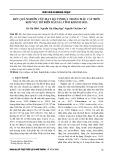
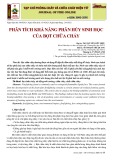
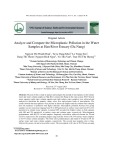


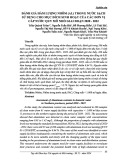
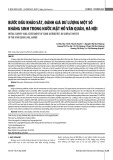


![Tài liệu Vi sinh vật môi trường [Mới nhất]](https://cdn.tailieu.vn/images/document/thumbnail/2025/20251123/ngkimxuyen/135x160/21891763953413.jpg)
![Sổ tay truyền thông Phân loại chất thải rắn sinh hoạt trên địa bàn tỉnh Quảng Nam [Chuẩn nhất]](https://cdn.tailieu.vn/images/document/thumbnail/2025/20251114/kimphuong1001/135x160/1701763094001.jpg)


![Quản lý chất thải nguy hại: Sổ tay Môi trường [Chuẩn nhất]](https://cdn.tailieu.vn/images/document/thumbnail/2025/20251029/kimphuong1001/135x160/9011761720170.jpg)









